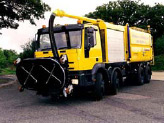Today, three runway cleaning methods come forward, each having their advantages and disadvantages
- Cleaning with Pressurized Water Jet
- Cleaning with Chemicals
- Cleaning with Compressed Hot Air
We shall focus on methods 1 and 2 and compare them to each other as those two have been the most widely used.
Cleaning with Pressurized Water Jet
 High pressure water jets are used to clean the rubber residue on the runway. This method is based on the application of water jet pressurized at 500 to 2500bars. When the water hits the surface with such power, it simply sweeps all rubber residues from the surface of the runway. However, there is factor of balance between the cleaning effect and the e it causes. potential collateral damage it causes. High pressure water jets are used to clean the rubber residue on the runway. This method is based on the application of water jet pressurized at 500 to 2500bars. When the water hits the surface with such power, it simply sweeps all rubber residues from the surface of the runway. However, there is factor of balance between the cleaning effect and the e it causes. potential collateral damage it causes.
 When the jet is applied with maximum power, while sweeping and cleaning the rubber thoroughly, it damages the anti skid layer that is crucial to maintain the high safety standards of the runway. On the other hand, if lower pressure is applied to protect the anti skid layer, the system fails to completely clean the rubber. Another disadvantage of water jet is the fact that the vehicles applying water jet move with a ground speed of approximately 2km/hr. As an example of the total work hour, the Kennedy Airport’s runways present a surface area of approximately 110.000 m2 out of which over 60.000 m2 need constant cleaning of rubber. That is a work of weeks considering the runway can be closed to traffic for rubber cleaning for maximum 6 hours a day. When the jet is applied with maximum power, while sweeping and cleaning the rubber thoroughly, it damages the anti skid layer that is crucial to maintain the high safety standards of the runway. On the other hand, if lower pressure is applied to protect the anti skid layer, the system fails to completely clean the rubber. Another disadvantage of water jet is the fact that the vehicles applying water jet move with a ground speed of approximately 2km/hr. As an example of the total work hour, the Kennedy Airport’s runways present a surface area of approximately 110.000 m2 out of which over 60.000 m2 need constant cleaning of rubber. That is a work of weeks considering the runway can be closed to traffic for rubber cleaning for maximum 6 hours a day.
Cleaning with Chemicals
The chemical is sprayed onto the dirty surface by a sprayer truck. There is 30-40 minutes waiting time till the chemical penetrates the rubber and melts it. Once the rubber is softened, by use of low pressure water jet at 100 – 120 bars (Equal to pressure used by car wash jets) the soft and broken rubber is swept off the runway surface.
With the use of low pressure water jet, the anti skid layer is protected from being damaged. Consequently, the cleaning internal, instead of once a year is decreased to twice or three times a year. This does not only mean a more effective and efficient runway maintenance but also an highly increased factor of safety on the runway.
However, at this point we must mention a factor which makes the chemical system less usable than the other :
 ENVIRONMENTAL PROTECTION and PERSONNEL HEALTH ENVIRONMENTAL PROTECTION and PERSONNEL HEALTH
Chemicals have been used in the runway cleaning process, but they have caused as many disadvantages as advantages.
We shall see the runway cleaning chemicals in two basic groups:
Strong Acids and alkalis.
Dense acids used to melt the rubber such as hydrochloric acid, while working the rubber, damage the surface of the runway. Their storage has to be done with care. Moreover, not only during the application but also after the application and at the cleaning stage, they entertain a risk for the environmental and personnel's health.
The second group is alkali solutions. Caustic Soda is used in runway doesn't damage the concrete, however and more importantly, it poses a strong threat to environment and personnel health. It needs to be stored with excessive care, used with caution and its disposal has to be in compliance with strict regulation. Alkali solutions are generally not preferred due to the fact that they have to be diluted with water and the ratio may reach 1/30. With all the disposal regulations to be complied with and the cost of dilution, base solutions are not widely preferred. |


